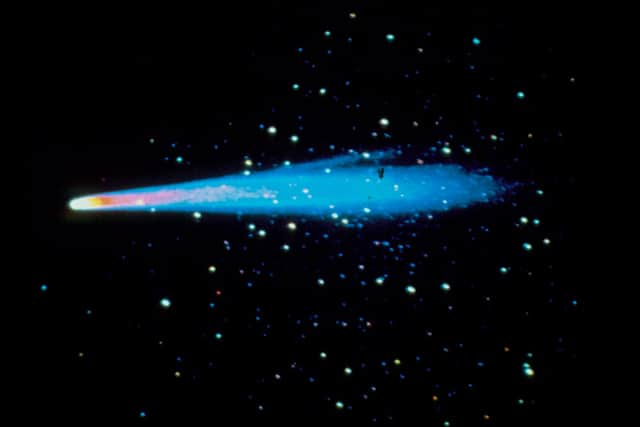Stargazers set for Halley's Comet meteor shower display
Skygazers can look forward to seeing a hail of shooting stars as the Earth passes through dust left over from Halley’s Comet this week.
The Eta Aquariid meteor shower is expected to peak on Tuesday night, with up to 40 meteors streaking through the sky every hour, and will be visible until early on Wednesday morning.
Advertisement
Hide AdAdvertisement
Hide AdThe best chance of witnessing the celestial display is from a place away from street lamps and other lighting.


And since there will be a gibbous moon in the sky, it’s advised to use a building or other obstacle to blot it out and afford as clear and dark a view as possible.
The heavenly phenomenon is associated with Halley's Comet, officially designated 1P/Halley, which orbits the sun once every 76 years.
Tania de Sales Marques, an astronomer at the Royal Observatory Greenwich, said: “The last time it [Halley’s Comet] was seen in the sky was 1986, and our next chance to view it will be late in the year 2061.”
The Eta Aquariid takes its name from the constellation of Aquarius in the southern hemisphere, where the shooting stars appear to originate from.
Meteoroids from Halley’s Comet strike Earth’s atmosphere at an approximate speed of 150,000 miles per hour, burning up in the process.
“As a comet approaches the sun it heats up, releasing gas and dust into space behind it,” Ms de Sales Marques said.
“When that wake of debris intersects with the orbit of the Earth we experience meteor showers, as the particles fall towards the Earth and heat up upon entering the atmosphere, leaving bright streaks in the sky as they vaporise or break apart.”
Advertisement
Hide AdAdvertisement
Hide AdWhile the Eta Aquariid is active from late April to near the end of May, the astronomer says the best time to see it will be on the night of 5-6 May between midnight and sunrise, when the shower will be at its peak.
Ms de Sales Marques added: “This is a moderately active meteor shower, with a peak rate of 40 meteors per hour, and even though its radiant will be below or only just above the horizon for those of us at London’s latitude, we can still look out for its meteors all across the sky.
“Our best chance will be in the hours just before dawn, facing the eastern sky.”
She advises getting far away from all artificial lights to increase the chances of catching a glimpse of the shooting stars on a moonlit night.
“As with any other stargazing activity, the best way to see meteors is to find yourself a spot sheltered from city lights with an unobstructed view of the sky and look in the direction of the radiant,” she said.
“The moon will be waxing gibbous throughout the night, so the sky won’t be as dark as one could hope, adding to the challenge.”
A message from the Editor:
Thank you for reading this story on our website. While I have your attention, I also have an important request to make of you.
With the coronavirus lockdown having a major impact on many of our advertisers - and consequently the revenue we receive - we are more reliant than ever on you taking out a digital subscription.
Advertisement
Hide AdAdvertisement
Hide AdSubscribe to scotsman.com and enjoy unlimited access to Scottish news and information online and on our app. With a digital subscription, you can read more than 5 articles, see fewer ads, enjoy faster load times, and get access to exclusive newsletters and content. Visit https://www.scotsman.com/subscriptions now to sign up.
Our journalism costs money and we rely on advertising, print and digital revenues to help to support them. By supporting us, we are able to support you in providing trusted, fact-checked content for this website.
Joy Yates
Editorial Director
Comments
Want to join the conversation? Please or to comment on this article.